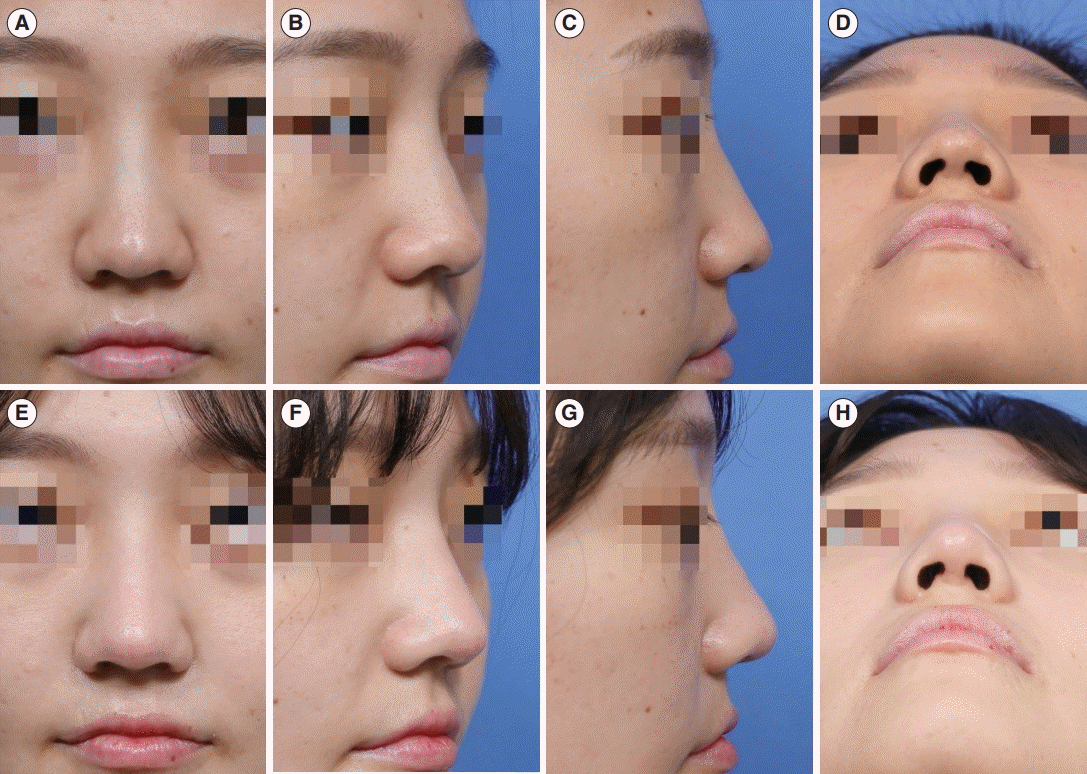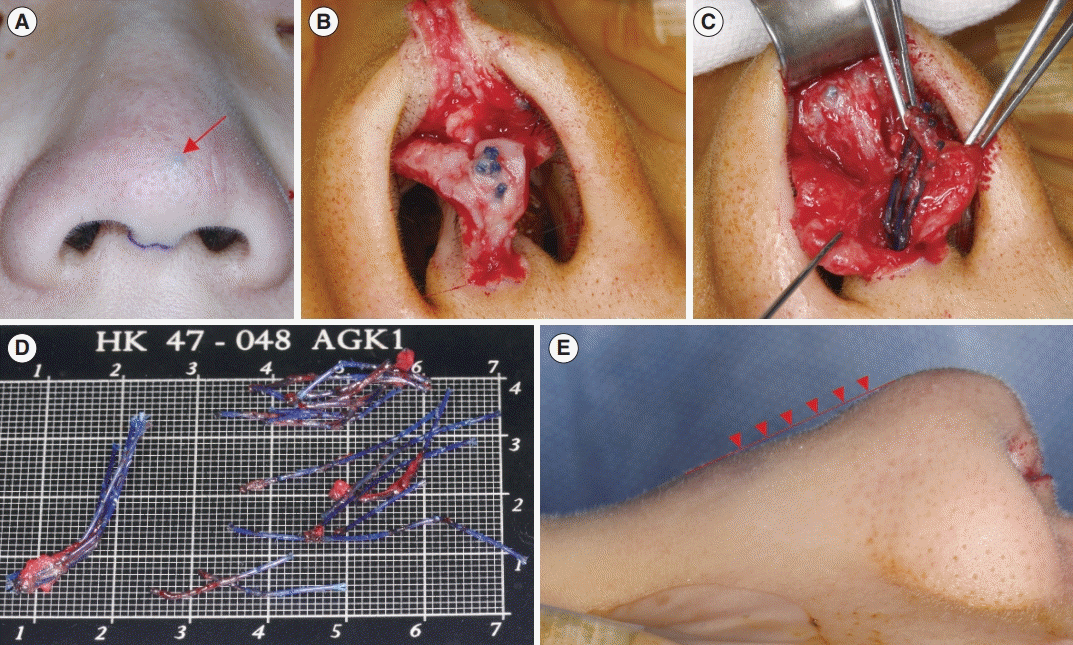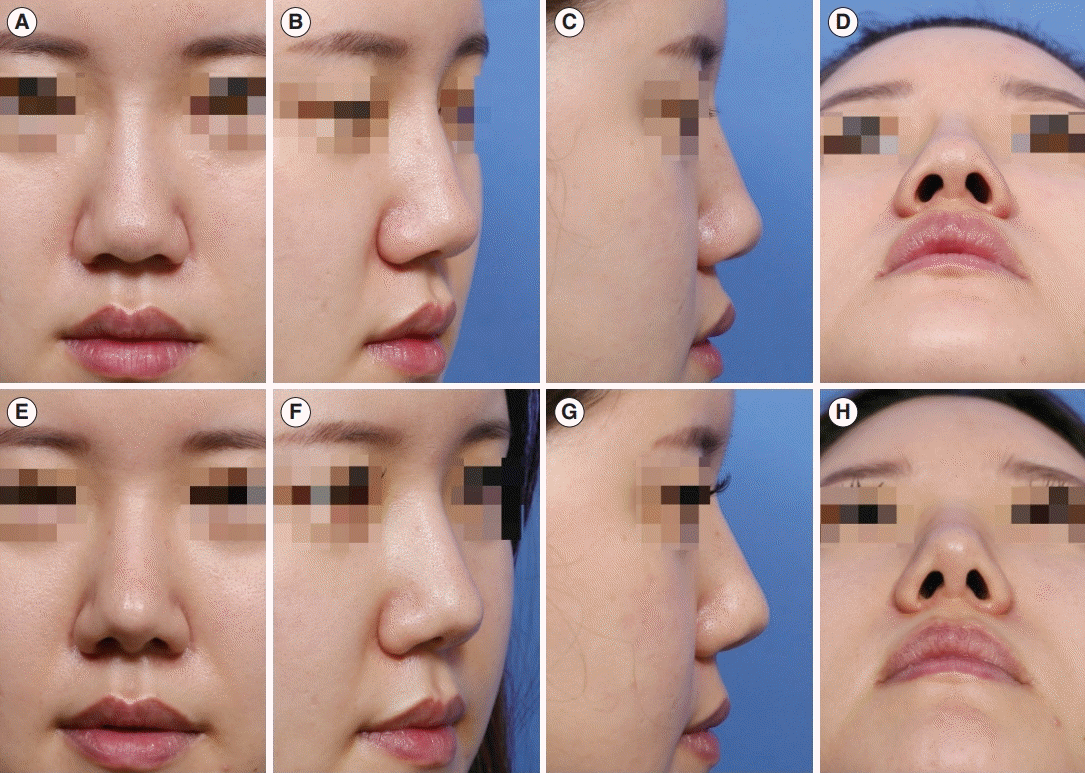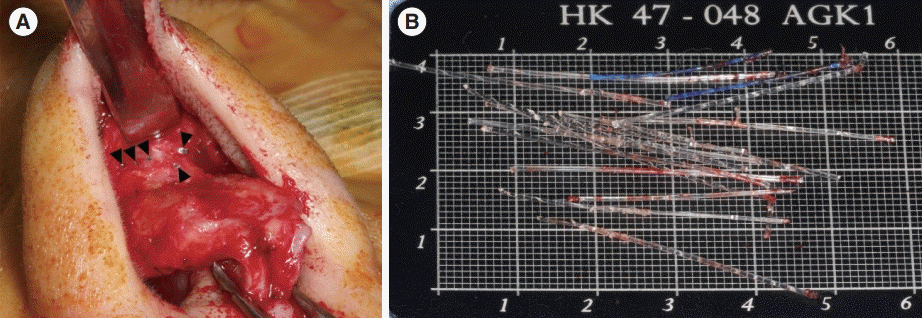INTRODUCTION
Since absorbable threads were first used for facelifts in the late 1990s [
1], the use of threads was subsequently extended to rhinoplasty and became highly popular with the trend of favoring minimally invasive procedures in facial aesthetic surgery [
2]. Synthetic, absorbable, monofilament polydioxanone (PDO) sutures, which are slowly absorbed by hydrolysis over several months, are most commonly used in thread rhinoplasty [
3]. PDO sutures have a barbed structure, such that multiple barbs are caught by tissue fibers and thus can firmly attach [
4]. The threads can be inserted in the nasal dorsum, nasal tip, or both, with several threads inserted into each structure. For improved aesthetic outcomes, thread rhinoplasty is commonly combined with filler injection or fat grafting to supplement the deficient volume [
4-
6]. Nonsurgical rhinoplasty using barbed threads is emphasized as a safe and straightforward procedure free from anesthesia, the post-surgical recovery process, and surgery-related complications. Therefore, thread rhinoplasty is currently widely performed in daily practice.
Several studies have reported the techniques and surgical outcomes of nonsurgical rhinoplasty using barbed threads [
4,
5,
7]. They noted that thread rhinoplasty is an effective alternative to conventional rhinoplasty, with high patient satisfaction and no or few minor complications. While the benefits of thread rhinoplasty have been emphasized, its complications tend to be overlooked [
8]. Only a few studies have reported complications of thread rhinoplasty, and they were limited to cases of inflammation or infection [
9,
10]. Some patients in a previous report experienced severe infection, including abscess and skin necrosis with an open wound [
9]. However, other complications, such as thread extrusion, palpable threads, or aesthetic dissatisfaction, have not been reported. Surgical techniques and considerations for revising those cases have never been reported, despite their clinical importance. As thread rhinoplasty is becoming more popular, the incidence of these complications is also increasing, and the demand for revision surgery will also increase. In this study, we reviewed a case series of revision rhinoplasty performed due to complications of thread rhinoplasty, and reported the presentation patterns of the complications, the surgical management, and the outcomes.
Go to :

MATERIALS AND METHODS
This study is a retrospective review of patients who underwent revision rhinoplasty for the complications of thread rhinoplasty, performed by Dr. Hong Ryul Jin at Dr. Jin’s Premium Nose Clinic in Seoul, Republic of Korea. The study was approved by the Institutional Review Board of the National Medical Center (IRB No. 2021-0292-001). The informed consent was waived due to the retrospective nature of the study. However, written informed consent for the use of pre- and postoperative facial photographs was obtained from all patients before surgery with a full explanation.
Seven patients who underwent revision rhinoplasty due to complications and/or aesthetic dissatisfaction after thread rhinoplasty from January 2018 to May 2021 were analyzed (
Table 1). They comprised six females and one male, and their mean age was 26±6 years (range, 18–36 years). The patients had a history of thread rhinoplasty at various clinics. We reviewed the medical record to obtain the following information: chief complaint, the reason for seeking revision rhinoplasty, time of thread insertion, and accompanied procedures with thread insertion. Status of the thread (shape and degree of absorption), location, number of inserted threads, and the degree of adhesion with the surrounding tissues were analyzed with operative photos and surgical records. Detailed surgical techniques, the type of autologous tissue used for revision, and any significant findings during the surgery were also recorded and reviewed. The surgical outcome was measured as patient satisfaction with categorical variables (very satisfied, satisfied, and dissatisfied). For statistical analysis, a descriptive analysis was performed using IBM SPSS ver. 27.0 software (IBM Corp., Armonk, NY, USA).
Table 1.
|
Sex/age (yr) |
Reason for revision |
Time from thread insertion |
Number of threads removed |
Thread type |
Insertion site |
Thread status |
Graft material |
Technique used for revision rhinoplasty |
Follow-up (mo) |
Result |
|
F/26 |
Visible threads at the tip, pain |
7 yr |
21 |
Barbed, dyed |
Dorsum, tip |
Intact |
Septal cartilage, postauricular soft tissue |
Dorsal onlay graft, columellar strut, tip onlay graft, camouflage with soft tissue (tip, dorsum) |
13 |
Very satisfied |
|
F/27 |
Deviated, palpable dorsal threads, bulbous tip |
NA |
17 |
Barbed, dyed (2), and undyed (15) |
Dorsum, tip |
Intact |
Conchal cartilage, temporalis fascia |
Dorsal onlay graft, tip only graft |
16 |
Very satisfied |
|
F/32 |
Bulbous tip, low dorsum, deviated septum |
2 yr |
14 |
Barbed, undyed |
Dorsum, tip |
Intact |
Autologous rib, perichondrium |
Dorsal onlay graft, revision septal reconstruction, septal extension graft, camouflage with perichondrium (dorsum) |
25 |
Very satisfied |
|
M/36 |
Thread extrusion at the tip and the vestibule |
5 yr |
13 |
Barbed, dyed |
Dorsum, tip |
Intact |
Autologous rib, perichondrium, septal cartilage |
Dorsal onlay graft, columellar strut, tip onlay graft, LLC onlay graft, camouflage with perichondrium (tip, dorsum) |
40 |
Very satisfied |
|
F/21 |
Visible threads at the tip with skin dimpling, hump |
NA |
5 |
Barbed, undyed |
Tip |
Intact |
Septal cartilage |
Hump removal, dorsal onlay graft, spreader graft, septal extension graft, tip onlay graft |
48 |
Very satisfied |
|
F/18 |
Visible dorsum threads, hump, deviated nose |
2 mo |
10 |
Barbed, dyed |
Dorsum, tip |
Intact |
Septal cartilage, temporalis fascia |
Dorsal onlay graft, spreader graft, cephalic resection, septal extension graft, tip onlay graft |
18 |
Added filler at mid-dorsum |
|
F/27 |
Visible threads at the tip |
NA |
13 |
Barbed, dyed |
Dorsum, tip |
Intact |
Septal cartilage, fascia (allograft) |
Dorsal only graft, columellar strut, tip only graft |
7 |
Very satisfied |

Go to :

RESULTS
Presentation patterns and treatment outcomes
The mean duration from thread insertion to revision surgery was 3.54±3.04 years (range, 2 months–7 years). Six out of seven patients had thread insertion both at the tip and dorsum. The primary reasons for revision were visible or extruded threads at the tip (five patients), a palpable thread on the dorsum (one), and other aesthetic issues (one patient). One patient experienced thread extrusion at the tip, bilateral vestibules, and membranous septum. Another complained of pain along the site of thread insertion. Most patients wanted to correct concomitant aesthetic issues, including a bulbous and under-projected tip, nasal deviation, or hump nose, along with thread removal.
Patients were followed up postoperatively from 7 to 48 months after revision rhinoplasty. Six patients were satisfied with the outcomes of revision rhinoplasty. However, one needed minimal touch-up with filler to fill a slight depression on the mid-dorsum.
Surgical findings of revision rhinoplasty
Threads were removed from both the tip and dorsum in six patients, and from the tip only in one patient (
Table 1). The mean number of threads removed from both the tip and dorsum was 14.67±3.83 (range, 10–21). The number of threads removed from the tip only was 5. The threads were barbed in all patients and dyed in four patients. The dyed threads were easier to locate than the non-dyed, white threads. All the threads were almost intact and had their original shape with cogs. Minimal to no resorption was observed even several years after insertion. After the thread removal, weakened tip support and dorsal irregularities were observed in all cases.
Surgical techniques of revision rhinoplasty
In all patients, open rhinoplasty was performed under general anesthesia to efficiently remove the threads and perform the necessary techniques to achieve the aesthetic goals. The threads inserted in the tip area were easily identified after skin flap elevation, and they were easily removed after interdomal dissection. However, multiple long threads inserted into the level of the anterior nasal spine required deep dissection for removal. It was necessary to remove the soft tissue attached to the threads, resulting in the loss of tip support.
Dorsal threads required careful dissection, because they were embedded within the scarred subcutaneous tissues, and granulation tissue was often observed around them. The threads in patients with thin skin were easily located, whereas locating the threads was difficult in patients with thick skin. After identifying the threads and dissecting the soft tissue around them, an attempt was made to pull them out using mosquito forceps. However, attention was required, because pulling the threads could cause soft tissue damage. If resistance with skin retraction was felt when the threads were pulled, careful dissection was performed to prevent inadvertent skin damage. After removing all the threads, the nose shape was carefully evaluated. Any dorsal irregularity or dimpling was restored using an autologous tissue graft. Minor dorsal irregularities were camouflaged with soft tissue, such as the temporalis fascia or postauricular soft tissue, while a significant depression was filled with a cartilage graft. The lost tip support was restored with either a columellar strut or a septal extension graft with a tip onlay graft.
The materials used for graft or soft tissue reinforcement depended on the anatomical abnormalities after thread removal and the patient’s aesthetic demands. Minor changes were achieved using septal or conchal cartilage. Restoring a major depression or augmentation of the dorsum to a higher level than the preoperative dorsal height required autologous rib cartilage.
Case 1
A 26-year-old woman visited our clinic for the removal of threads that had been inserted into her nose 7 years ago at another local clinic. A small bluish dot was observed at the nasal tip (
Fig. 1A-
D). She complained of pain upon palpation of the tip and dorsum. The tip was difficult to palpate due to tenderness. Irregular, slightly bluish thread lines, which were palpable and movable with skin stretching, were observed on the dorsum.
 | Fig. 1.A 26-year-old female patient presented with pain and visible threads at the nasal tip (case 1). Before (A-D) and 6 months after revision rhinoplasty (E-H). 
|
With an open approach, revision rhinoplasty with thread removal was performed. After skin flap elevation, protruding, navy blue, thick threads were easily identified at the dome (
Fig. 2A and
B). Further dissection between the medial crura revealed that the threads were deeply inserted into the anterior nasal spine (
Fig. 2C). With careful dissection, all the threads at the tip were removed completely (
Fig. 2D). However, the tip support weakened, and the projection decreased after thread removal.
 | Fig. 2.Intraoperative findings of case 1. (A) The threads are visible as a bluish dot at the nasal tip (red arrow). (B) After the skin flap elevation, multiple thick, dyed threads are easily identified between the intermediate crura. (C) Further dissection into the intercrural space shows that the threads are deeply inserted into the anterior nasal spine. (D) Multiple barbed threads are removed from the tip and the dorsum. The threads are intact in their original shape even 7 years after insertion. (E) The dorsum shows a depression with irregularities after the removal of all threads (red line and red arrowheads). 
|
Similar to the tip area, dorsal flap elevation revealed multiple barbed threads incorporated into the soft tissue of the dorsal skin. The threads were dispersed throughout the entire area of the dorsum. Therefore, they required careful soft tissue dissection until the threads were removed without resistance using mosquito forceps. The dorsum demonstrated a depression with irregularities after all the threads were removed (
Fig. 2E).
Tip projection was restored with a columellar strut and onlay graft using septal cartilage, and subsequently covered with postauricular soft tissue. Dorsal depression with irregularities was camouflaged using septal cartilage and postauricular soft tissue. The patient was followed up until 13 months after surgery and was highly satisfied with the surgical outcome (
Fig. 1E-
H).
Case 2
A 27-year-old woman visited our clinic for aesthetic improvement of her nose. She had undergone thread rhinoplasty at another clinic several years ago to improve the shape of the dorsum and tip, which resulted in unsatisfactory aesthetic outcomes. Threads were palpable on the dorsum, which was deviated to the right side, and the tip appeared bulbous (
Fig 3A-
D). Revision rhinoplasty with thread removal was performed with an open approach. Multiple transparent threads incorporated into the soft tissue of the tip and dorsum were removed (
Fig. 4). After thread removal, the tip support weakened, and a dorsum irregularity developed.
 | Fig. 3.A 27-year-old female patient complained of a bulbous tip with skin dimpling at the tip (case 2). Before (A-D) and 10 months after revision rhinoplasty (E-H). 
|
 | Fig. 4.Intraoperative findings of case 2. (A) Multiple transparent threads incorporated into the soft tissue of the dorsum are observed (black arrowheads). (B) Removed threads. 
|
A tip onlay graft was performed using harvested conchal cartilage. The depressed and irregular dorsum was camouflaged with conchal cartilage and folded temporalis fascia. Ten months after surgery, the deviated dorsum and the tip bulbosity improved (
Fig. 3E-
H), and the patient was highly satisfied with the surgical outcome.
Go to :

DISCUSSION
A notable aspect of our study was that the threads were not resorbed even years after insertion. In most patients, the threads maintained their original shape and volume with intact cogs. It is known that the PDO threads used in thread rhinoplasty are absorbed into the tissue gradually by hydrolysis [
3]. An animal study using pigs revealed that the inserted threads became fragmented by 24 weeks and completely dissolved by 48 weeks [
11]. In that experimental study, USP 4-0 non-barbed PDO threads were inserted separately at 1-cm intervals. The histological changes of the surrounding tissues after thread insertion included collagen production, the development of new fibrous connective tissue that merged with the existing tissue, fat reduction, tissue contracture, and improved vascular supply [
11]. A rat model study using four different PDO thread types (single-stranded, 4-stranded, 12-stranded, and barbed cog threads) also demonstrated a similar tissue response and collagen formation, with 24 weeks taken for degradation [
12]. The factors contributing to these tissue changes have not yet been elucidated.
Possible explanations for the intact threads even years after surgery in our cases are as follows. First, although the threads were made of absorbable components, thick threads rarely dissolve in the nose tissue, where the soft tissue layer is rather thin. Second, when a filler is used concurrently with PDO threads, hyaluronic acid has been reported to block the chemical reaction between PDO and water, thereby prolonging the life of the PDO threads [
6]. In our series, the combined use of fillers was unclear due to the lack of previous medical records. Third, non-absorbable threads or a combination of absorbable and non-absorbable threads might have been used in the previous surgery. One study reported a complication with polypropylene non-absorbable threads [
10]. In Korea, a non-absorbable polypropylene product named Everko (Dongbang Medical, Seongnam, Korea) was once commercially available for thread rhinoplasty.
Thread exposure at the tip is mostly caused by an incorrect insertion technique. To prevent thread extrusion at the tip, the threads must be inserted deep in the tissue between the medial crura and should not reach higher than the intermediate crus, retaining a sufficient cushion layer on the top of the upper end [
6]. If the thread is not inserted deep enough or a longer thread is inserted, the chance for extrusion or a visible thread at the tip skin increases. Because the tip is a mobile portion with relatively poor blood circulation, an improper insertion technique inevitably results in pain, thread exposure, or infection [
9]. The removal of tip threads often reduces tip projection. When multiple threads are removed by deep intercrural dissection, the tip support is lost due to weak medial crura with a slight loss of intercrural tissue. Tip support must be restored either with a columellar strut or septal extension graft for an improved aesthetic result. All patients in our series needed tip support restoration using a combination of a columellar strut, septal extension graft, and onlay graft.
In our series, thread removal on the dorsum was inevitably accompanied by a slight tissue loss and dorsal irregularity, especially in patients with think skin. The patterns of thread cogs grasp the tissue firmly and prevent extrusion. This advantage may act as a disadvantage when removing the threads. Since tissue adhered to the cog prevents slippage of the thread, removal requires careful tissue dissection. This may cause a slight tissue loss on the dorsum and dorsal skin irregularities. Because most patients wanted a raised bridge or at least a regular dorsum after thread removal, dorsal camouflage or augmentation was necessary to achieve an improved dorsal shape. For natural-looking camouflage, soft tissue such as the fascia or perichondrium was helpful [
13]. We used the temporalis fascia in two patients, the postauricular soft tissue in one, and rib perichondrium in another for dorsal skin camouflage.
Although our series did not have such cases, severe infections, including abscess and skin necrosis with an open wound, have also been reported [
9]. Suggested factors contributing to infection are a previously inserted allograft, the insertion of too many threads, absence of aseptic preparation, anatomical features, and the high absorbability of PDO threads that increases the inflammation around the threads [
9]. Absorbable PDO has hydrophilic properties and therefore elicits a more severe tissue inflammatory reaction than non-absorbable threads [
10]. All previously reported infections occurred when PDO threads were used [
9,
10].
It is not clear how many threads should ideally be inserted. In previous studies describing the surgical technique of thread rhinoplasty, the authors described different numbers of threads on the dorsum and the columella [
4-
6]. The number of inserted threads can be influenced by skin thickness, types of threads, combined fat grafting, or the use of hyaluronic acid filler injection. Most reports described two to five threads on the dorsum and two to five threads on the columella, resulting in a total of four to 10 threads [
4-
6]. Two additional threads were inserted into each alar rim to reduce the nostril show as necessary [
4]. Our case series showed an average of 14.67±3.83 threads (range, 10–21), which is much more than reported in previous studies describing the surgical technique (range, 4–10) [
4-
6].
Thread rhinoplasty can be an effective way to increase mild tip ptosis, or when a slight volume increase of the dorsum is needed in patients with thick skin. However, surgical rhinoplasty using grafts is preferable when a considerable change of the tip projection or dorsal height is required. In our case series, many threads were overly inserted into the tip and the dorsum to achieve a considerable change, and these overdone procedures resulted in complications. Although thread rhinoplasty is a simple procedure that can be performed in an outpatient clinic with minimal anesthesia, the surgeon should be aware of the proper techniques, limitations, and possible complications of thread rhinoplasty.
This study has limitations, as it is a small case series with limited information on the previous procedures. Further studies with a larger case series and more information regarding the previous thread insertion are needed. Nevertheless, this is the first case series reporting detailed surgical techniques and considerations for revision rhinoplasty to correct the complications of thread rhinoplasty, and the findings are expected to be helpful for both patients and surgeons to recognize the risks of thread rhinoplasty and approach the surgical management of such complications.
In this case series of complications of thread rhinoplasty, we found that the threads maintained their original shape without undergoing resorption even years after insertion. Thread removal required careful dissection due to adherent tissue around the cog, inevitably causing a slight loss of the surrounding soft tissue with structural weakening. Reinforcement of the tip support and camouflage of possible dorsal irregularity are key steps for an improved aesthetic outcome.
Go to :






 PDF
PDF Citation
Citation Print
Print






 XML Download
XML Download